Robert Frost's 'The Road Not Taken': A Stylistic Analysis of the Poem
VerifiedAdded on 2022/10/06
|10
|2952
|6
Essay
AI Summary
This paper presents a stylistic analysis of Robert Frost's poem, 'The Road Not Taken.' The analysis examines various aspects, including phonological, graphological, semantic, grammatical, and lexico-syntactic patterns. The study focuses on how Frost uses stylistic devices to convey his message and themes, which are universally applicable. The paper explores the poem's structure, including rhyme scheme and meter, and discusses figures of speech like assonance, consonance, alliteration, onomatopoeia, imagery, personification, metaphor, and paradox. The essay also covers the levels of stylistic analysis, such as phonetic, phonological, graphological, grammatical, and lexico-syntactic levels, to provide a comprehensive understanding of the poem's style and meaning. The author uses the stylistic analysis to understand the hidden meanings of the poem, the choices of words, grammatical structures, paradox, ambiguity, irony, and the rhyme scheme, rhythm and meter to understand the meaning of the poem and the choices that the poet makes.
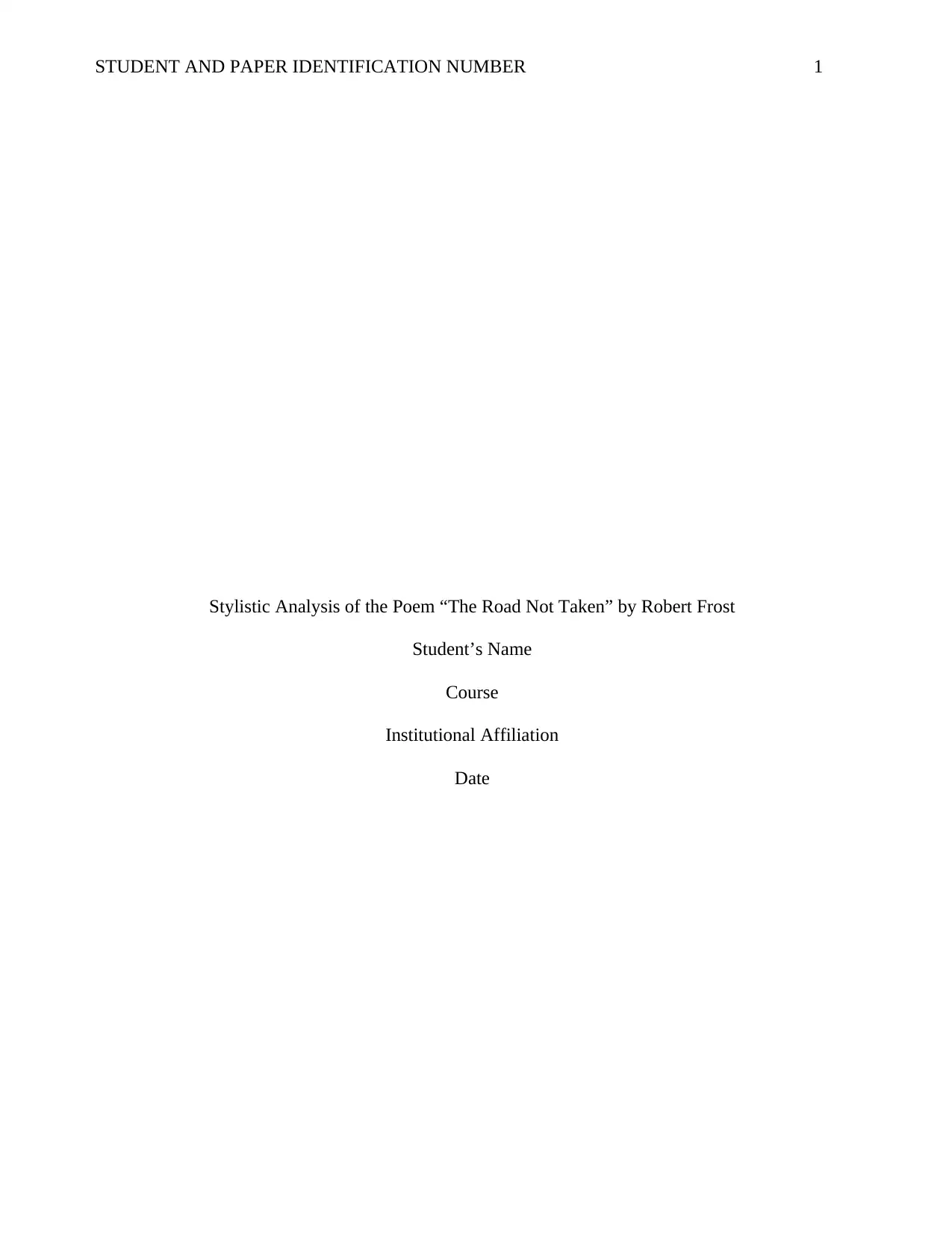
STUDENT AND PAPER IDENTIFICATION NUMBER 1
Stylistic Analysis of the Poem “The Road Not Taken” by Robert Frost
Student’s Name
Course
Institutional Affiliation
Date
Stylistic Analysis of the Poem “The Road Not Taken” by Robert Frost
Student’s Name
Course
Institutional Affiliation
Date
Paraphrase This Document
Need a fresh take? Get an instant paraphrase of this document with our AI Paraphraser
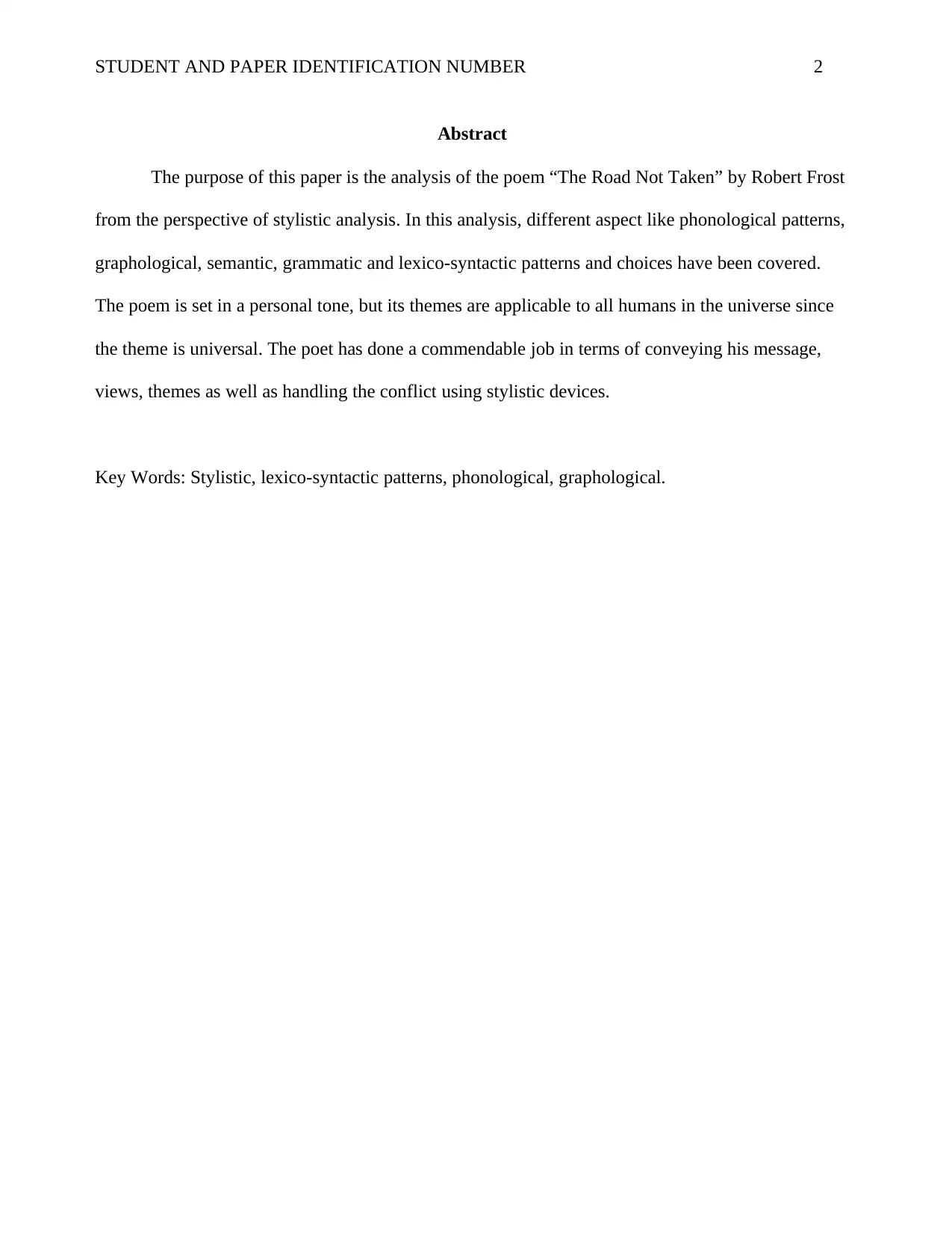
STUDENT AND PAPER IDENTIFICATION NUMBER 2
Abstract
The purpose of this paper is the analysis of the poem “The Road Not Taken” by Robert Frost
from the perspective of stylistic analysis. In this analysis, different aspect like phonological patterns,
graphological, semantic, grammatic and lexico-syntactic patterns and choices have been covered.
The poem is set in a personal tone, but its themes are applicable to all humans in the universe since
the theme is universal. The poet has done a commendable job in terms of conveying his message,
views, themes as well as handling the conflict using stylistic devices.
Key Words: Stylistic, lexico-syntactic patterns, phonological, graphological.
Abstract
The purpose of this paper is the analysis of the poem “The Road Not Taken” by Robert Frost
from the perspective of stylistic analysis. In this analysis, different aspect like phonological patterns,
graphological, semantic, grammatic and lexico-syntactic patterns and choices have been covered.
The poem is set in a personal tone, but its themes are applicable to all humans in the universe since
the theme is universal. The poet has done a commendable job in terms of conveying his message,
views, themes as well as handling the conflict using stylistic devices.
Key Words: Stylistic, lexico-syntactic patterns, phonological, graphological.
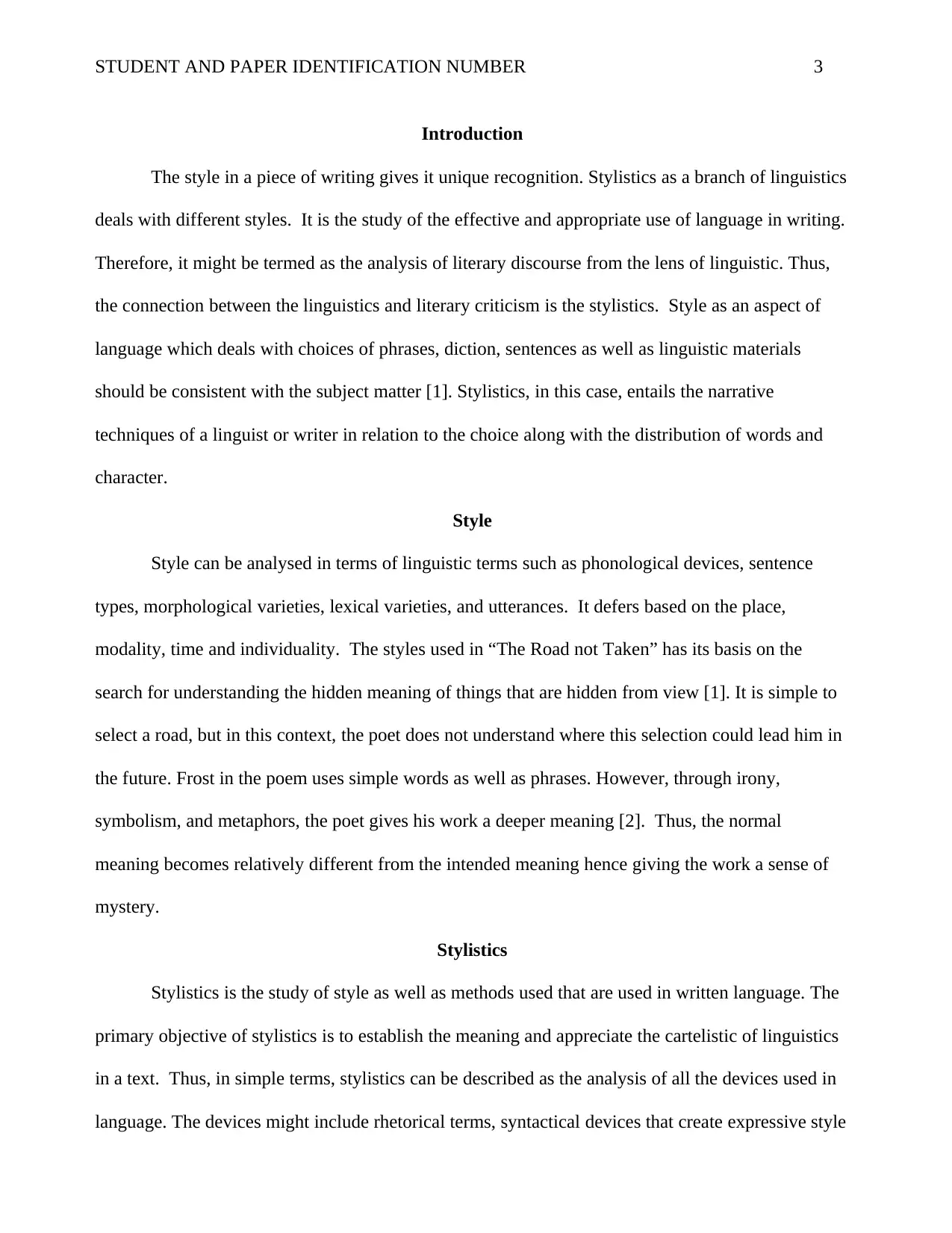
STUDENT AND PAPER IDENTIFICATION NUMBER 3
Introduction
The style in a piece of writing gives it unique recognition. Stylistics as a branch of linguistics
deals with different styles. It is the study of the effective and appropriate use of language in writing.
Therefore, it might be termed as the analysis of literary discourse from the lens of linguistic. Thus,
the connection between the linguistics and literary criticism is the stylistics. Style as an aspect of
language which deals with choices of phrases, diction, sentences as well as linguistic materials
should be consistent with the subject matter [1]. Stylistics, in this case, entails the narrative
techniques of a linguist or writer in relation to the choice along with the distribution of words and
character.
Style
Style can be analysed in terms of linguistic terms such as phonological devices, sentence
types, morphological varieties, lexical varieties, and utterances. It defers based on the place,
modality, time and individuality. The styles used in “The Road not Taken” has its basis on the
search for understanding the hidden meaning of things that are hidden from view [1]. It is simple to
select a road, but in this context, the poet does not understand where this selection could lead him in
the future. Frost in the poem uses simple words as well as phrases. However, through irony,
symbolism, and metaphors, the poet gives his work a deeper meaning [2]. Thus, the normal
meaning becomes relatively different from the intended meaning hence giving the work a sense of
mystery.
Stylistics
Stylistics is the study of style as well as methods used that are used in written language. The
primary objective of stylistics is to establish the meaning and appreciate the cartelistic of linguistics
in a text. Thus, in simple terms, stylistics can be described as the analysis of all the devices used in
language. The devices might include rhetorical terms, syntactical devices that create expressive style
Introduction
The style in a piece of writing gives it unique recognition. Stylistics as a branch of linguistics
deals with different styles. It is the study of the effective and appropriate use of language in writing.
Therefore, it might be termed as the analysis of literary discourse from the lens of linguistic. Thus,
the connection between the linguistics and literary criticism is the stylistics. Style as an aspect of
language which deals with choices of phrases, diction, sentences as well as linguistic materials
should be consistent with the subject matter [1]. Stylistics, in this case, entails the narrative
techniques of a linguist or writer in relation to the choice along with the distribution of words and
character.
Style
Style can be analysed in terms of linguistic terms such as phonological devices, sentence
types, morphological varieties, lexical varieties, and utterances. It defers based on the place,
modality, time and individuality. The styles used in “The Road not Taken” has its basis on the
search for understanding the hidden meaning of things that are hidden from view [1]. It is simple to
select a road, but in this context, the poet does not understand where this selection could lead him in
the future. Frost in the poem uses simple words as well as phrases. However, through irony,
symbolism, and metaphors, the poet gives his work a deeper meaning [2]. Thus, the normal
meaning becomes relatively different from the intended meaning hence giving the work a sense of
mystery.
Stylistics
Stylistics is the study of style as well as methods used that are used in written language. The
primary objective of stylistics is to establish the meaning and appreciate the cartelistic of linguistics
in a text. Thus, in simple terms, stylistics can be described as the analysis of all the devices used in
language. The devices might include rhetorical terms, syntactical devices that create expressive style
⊘ This is a preview!⊘
Do you want full access?
Subscribe today to unlock all pages.

Trusted by 1+ million students worldwide
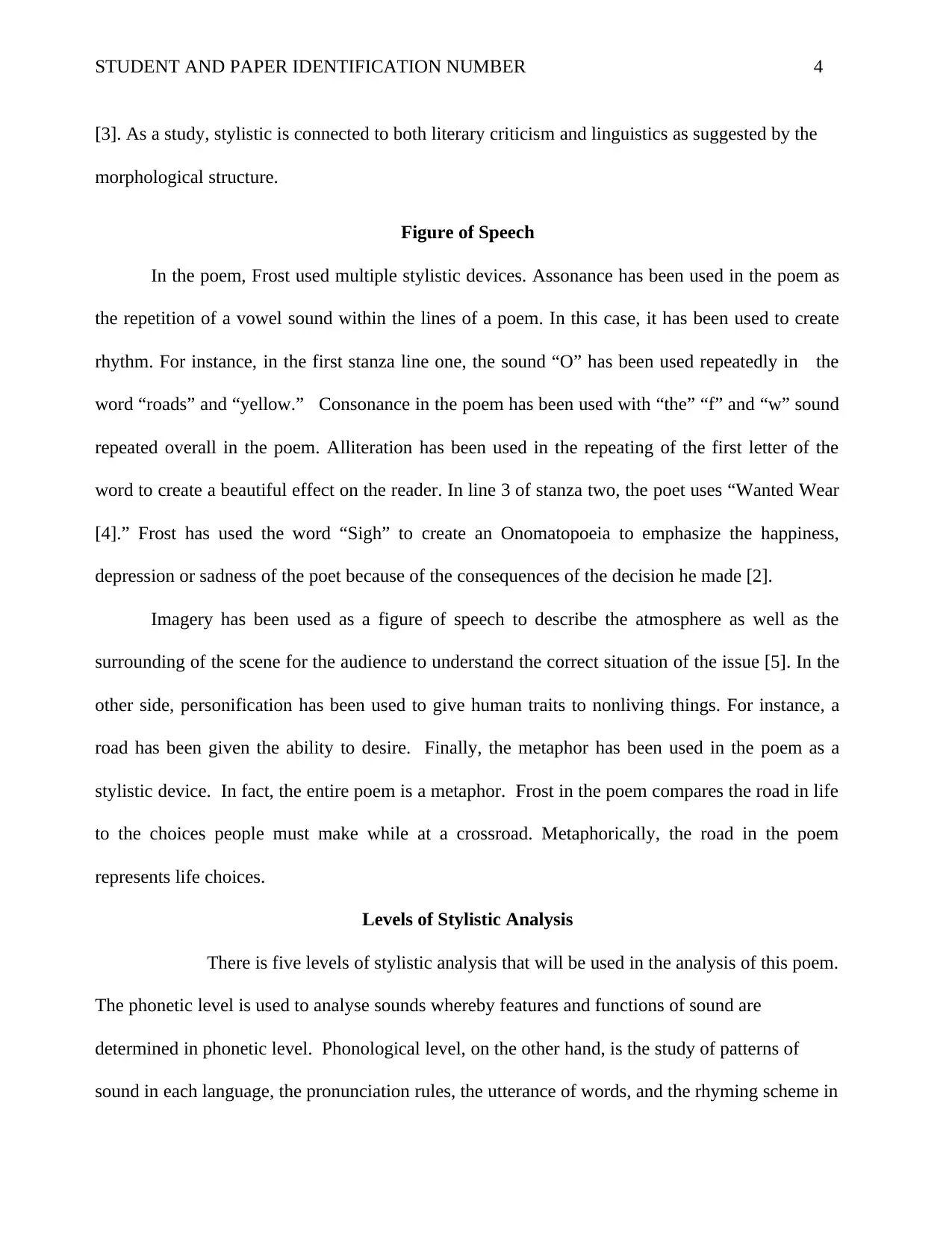
STUDENT AND PAPER IDENTIFICATION NUMBER 4
[3]. As a study, stylistic is connected to both literary criticism and linguistics as suggested by the
morphological structure.
Figure of Speech
In the poem, Frost used multiple stylistic devices. Assonance has been used in the poem as
the repetition of a vowel sound within the lines of a poem. In this case, it has been used to create
rhythm. For instance, in the first stanza line one, the sound “O” has been used repeatedly in the
word “roads” and “yellow.” Consonance in the poem has been used with “the” “f” and “w” sound
repeated overall in the poem. Alliteration has been used in the repeating of the first letter of the
word to create a beautiful effect on the reader. In line 3 of stanza two, the poet uses “Wanted Wear
[4].” Frost has used the word “Sigh” to create an Onomatopoeia to emphasize the happiness,
depression or sadness of the poet because of the consequences of the decision he made [2].
Imagery has been used as a figure of speech to describe the atmosphere as well as the
surrounding of the scene for the audience to understand the correct situation of the issue [5]. In the
other side, personification has been used to give human traits to nonliving things. For instance, a
road has been given the ability to desire. Finally, the metaphor has been used in the poem as a
stylistic device. In fact, the entire poem is a metaphor. Frost in the poem compares the road in life
to the choices people must make while at a crossroad. Metaphorically, the road in the poem
represents life choices.
Levels of Stylistic Analysis
There is five levels of stylistic analysis that will be used in the analysis of this poem.
The phonetic level is used to analyse sounds whereby features and functions of sound are
determined in phonetic level. Phonological level, on the other hand, is the study of patterns of
sound in each language, the pronunciation rules, the utterance of words, and the rhyming scheme in
[3]. As a study, stylistic is connected to both literary criticism and linguistics as suggested by the
morphological structure.
Figure of Speech
In the poem, Frost used multiple stylistic devices. Assonance has been used in the poem as
the repetition of a vowel sound within the lines of a poem. In this case, it has been used to create
rhythm. For instance, in the first stanza line one, the sound “O” has been used repeatedly in the
word “roads” and “yellow.” Consonance in the poem has been used with “the” “f” and “w” sound
repeated overall in the poem. Alliteration has been used in the repeating of the first letter of the
word to create a beautiful effect on the reader. In line 3 of stanza two, the poet uses “Wanted Wear
[4].” Frost has used the word “Sigh” to create an Onomatopoeia to emphasize the happiness,
depression or sadness of the poet because of the consequences of the decision he made [2].
Imagery has been used as a figure of speech to describe the atmosphere as well as the
surrounding of the scene for the audience to understand the correct situation of the issue [5]. In the
other side, personification has been used to give human traits to nonliving things. For instance, a
road has been given the ability to desire. Finally, the metaphor has been used in the poem as a
stylistic device. In fact, the entire poem is a metaphor. Frost in the poem compares the road in life
to the choices people must make while at a crossroad. Metaphorically, the road in the poem
represents life choices.
Levels of Stylistic Analysis
There is five levels of stylistic analysis that will be used in the analysis of this poem.
The phonetic level is used to analyse sounds whereby features and functions of sound are
determined in phonetic level. Phonological level, on the other hand, is the study of patterns of
sound in each language, the pronunciation rules, the utterance of words, and the rhyming scheme in
Paraphrase This Document
Need a fresh take? Get an instant paraphrase of this document with our AI Paraphraser
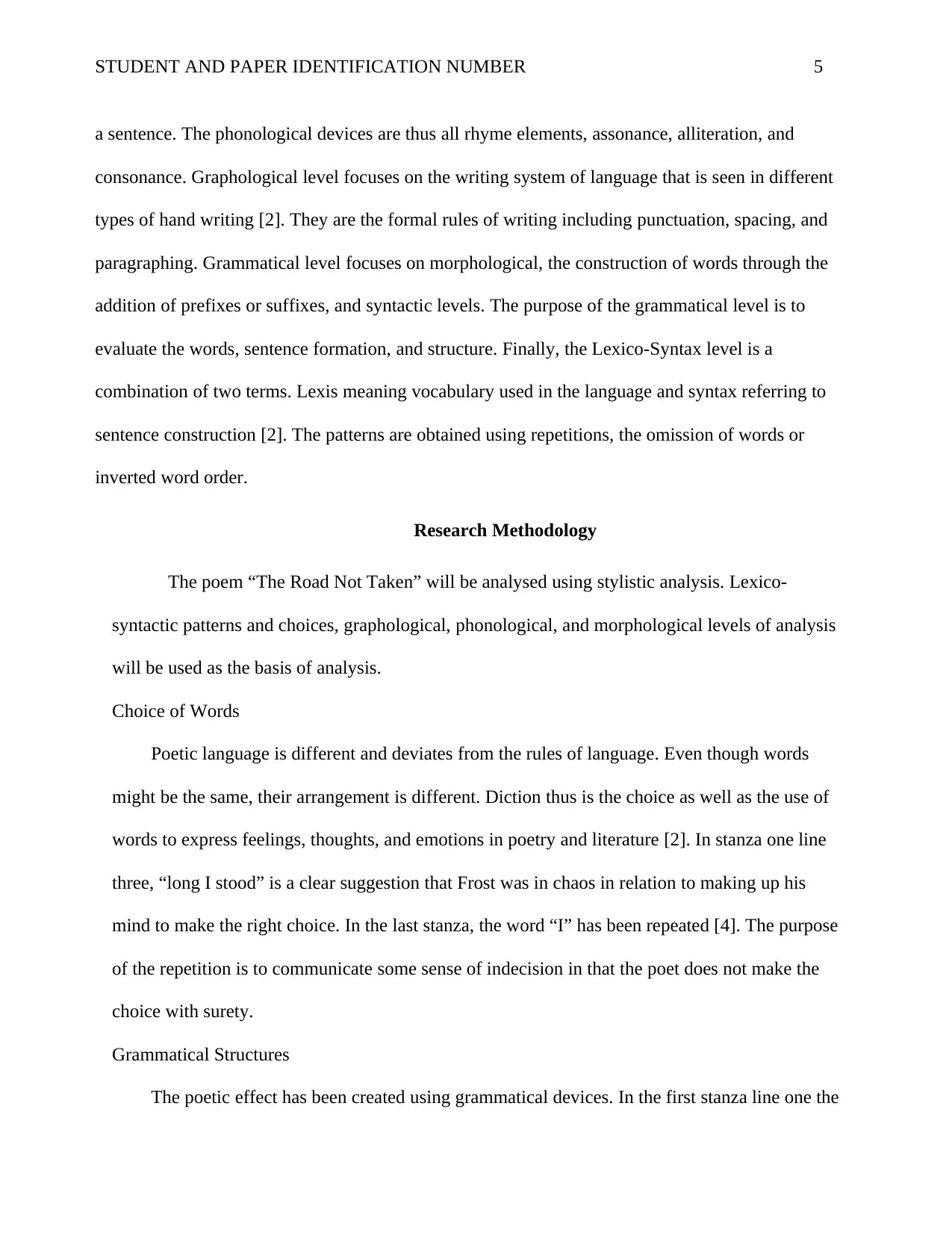
STUDENT AND PAPER IDENTIFICATION NUMBER 5
a sentence. The phonological devices are thus all rhyme elements, assonance, alliteration, and
consonance. Graphological level focuses on the writing system of language that is seen in different
types of hand writing [2]. They are the formal rules of writing including punctuation, spacing, and
paragraphing. Grammatical level focuses on morphological, the construction of words through the
addition of prefixes or suffixes, and syntactic levels. The purpose of the grammatical level is to
evaluate the words, sentence formation, and structure. Finally, the Lexico-Syntax level is a
combination of two terms. Lexis meaning vocabulary used in the language and syntax referring to
sentence construction [2]. The patterns are obtained using repetitions, the omission of words or
inverted word order.
Research Methodology
The poem “The Road Not Taken” will be analysed using stylistic analysis. Lexico-
syntactic patterns and choices, graphological, phonological, and morphological levels of analysis
will be used as the basis of analysis.
Choice of Words
Poetic language is different and deviates from the rules of language. Even though words
might be the same, their arrangement is different. Diction thus is the choice as well as the use of
words to express feelings, thoughts, and emotions in poetry and literature [2]. In stanza one line
three, “long I stood” is a clear suggestion that Frost was in chaos in relation to making up his
mind to make the right choice. In the last stanza, the word “I” has been repeated [4]. The purpose
of the repetition is to communicate some sense of indecision in that the poet does not make the
choice with surety.
Grammatical Structures
The poetic effect has been created using grammatical devices. In the first stanza line one the
a sentence. The phonological devices are thus all rhyme elements, assonance, alliteration, and
consonance. Graphological level focuses on the writing system of language that is seen in different
types of hand writing [2]. They are the formal rules of writing including punctuation, spacing, and
paragraphing. Grammatical level focuses on morphological, the construction of words through the
addition of prefixes or suffixes, and syntactic levels. The purpose of the grammatical level is to
evaluate the words, sentence formation, and structure. Finally, the Lexico-Syntax level is a
combination of two terms. Lexis meaning vocabulary used in the language and syntax referring to
sentence construction [2]. The patterns are obtained using repetitions, the omission of words or
inverted word order.
Research Methodology
The poem “The Road Not Taken” will be analysed using stylistic analysis. Lexico-
syntactic patterns and choices, graphological, phonological, and morphological levels of analysis
will be used as the basis of analysis.
Choice of Words
Poetic language is different and deviates from the rules of language. Even though words
might be the same, their arrangement is different. Diction thus is the choice as well as the use of
words to express feelings, thoughts, and emotions in poetry and literature [2]. In stanza one line
three, “long I stood” is a clear suggestion that Frost was in chaos in relation to making up his
mind to make the right choice. In the last stanza, the word “I” has been repeated [4]. The purpose
of the repetition is to communicate some sense of indecision in that the poet does not make the
choice with surety.
Grammatical Structures
The poetic effect has been created using grammatical devices. In the first stanza line one the
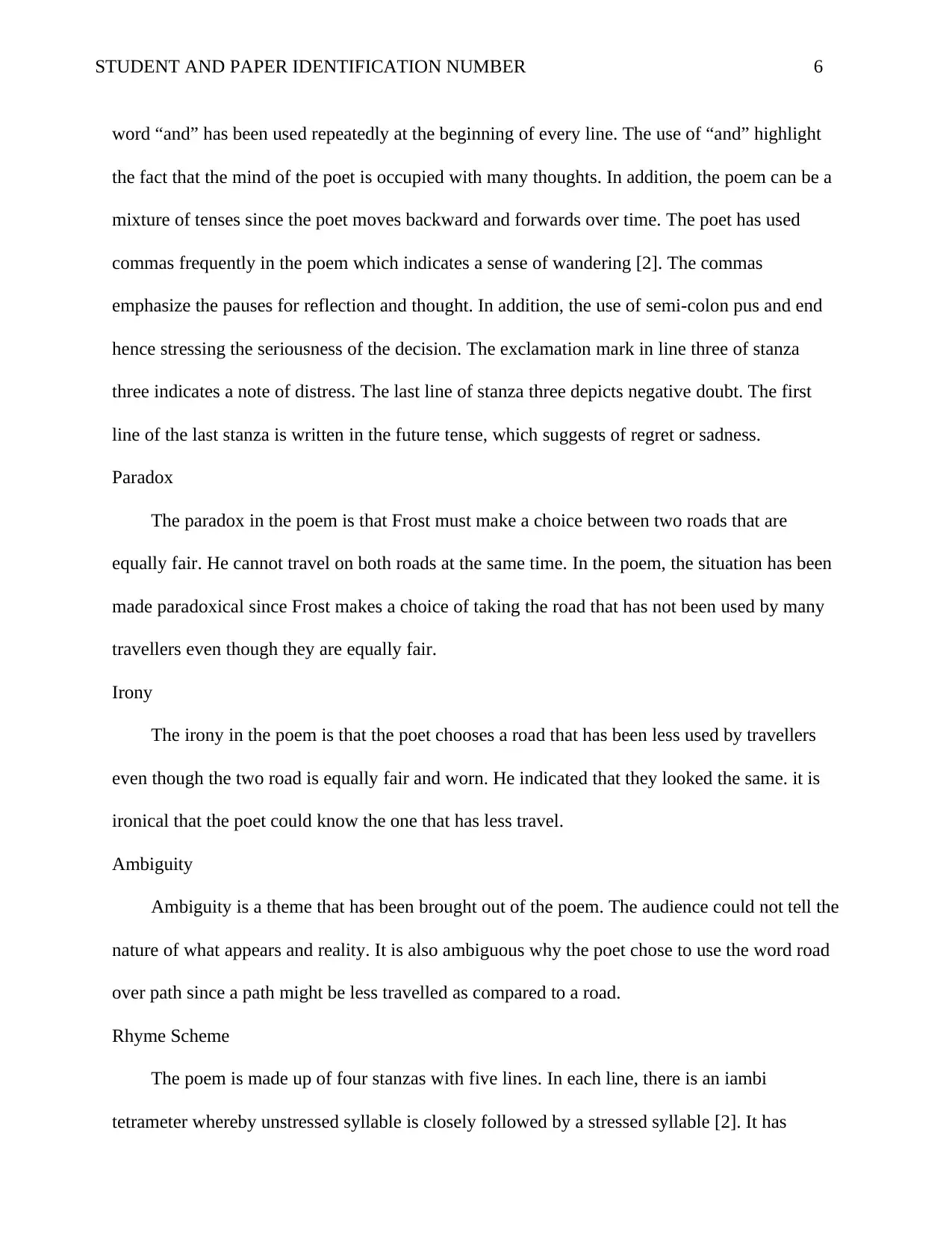
STUDENT AND PAPER IDENTIFICATION NUMBER 6
word “and” has been used repeatedly at the beginning of every line. The use of “and” highlight
the fact that the mind of the poet is occupied with many thoughts. In addition, the poem can be a
mixture of tenses since the poet moves backward and forwards over time. The poet has used
commas frequently in the poem which indicates a sense of wandering [2]. The commas
emphasize the pauses for reflection and thought. In addition, the use of semi-colon pus and end
hence stressing the seriousness of the decision. The exclamation mark in line three of stanza
three indicates a note of distress. The last line of stanza three depicts negative doubt. The first
line of the last stanza is written in the future tense, which suggests of regret or sadness.
Paradox
The paradox in the poem is that Frost must make a choice between two roads that are
equally fair. He cannot travel on both roads at the same time. In the poem, the situation has been
made paradoxical since Frost makes a choice of taking the road that has not been used by many
travellers even though they are equally fair.
Irony
The irony in the poem is that the poet chooses a road that has been less used by travellers
even though the two road is equally fair and worn. He indicated that they looked the same. it is
ironical that the poet could know the one that has less travel.
Ambiguity
Ambiguity is a theme that has been brought out of the poem. The audience could not tell the
nature of what appears and reality. It is also ambiguous why the poet chose to use the word road
over path since a path might be less travelled as compared to a road.
Rhyme Scheme
The poem is made up of four stanzas with five lines. In each line, there is an iambi
tetrameter whereby unstressed syllable is closely followed by a stressed syllable [2]. It has
word “and” has been used repeatedly at the beginning of every line. The use of “and” highlight
the fact that the mind of the poet is occupied with many thoughts. In addition, the poem can be a
mixture of tenses since the poet moves backward and forwards over time. The poet has used
commas frequently in the poem which indicates a sense of wandering [2]. The commas
emphasize the pauses for reflection and thought. In addition, the use of semi-colon pus and end
hence stressing the seriousness of the decision. The exclamation mark in line three of stanza
three indicates a note of distress. The last line of stanza three depicts negative doubt. The first
line of the last stanza is written in the future tense, which suggests of regret or sadness.
Paradox
The paradox in the poem is that Frost must make a choice between two roads that are
equally fair. He cannot travel on both roads at the same time. In the poem, the situation has been
made paradoxical since Frost makes a choice of taking the road that has not been used by many
travellers even though they are equally fair.
Irony
The irony in the poem is that the poet chooses a road that has been less used by travellers
even though the two road is equally fair and worn. He indicated that they looked the same. it is
ironical that the poet could know the one that has less travel.
Ambiguity
Ambiguity is a theme that has been brought out of the poem. The audience could not tell the
nature of what appears and reality. It is also ambiguous why the poet chose to use the word road
over path since a path might be less travelled as compared to a road.
Rhyme Scheme
The poem is made up of four stanzas with five lines. In each line, there is an iambi
tetrameter whereby unstressed syllable is closely followed by a stressed syllable [2]. It has
⊘ This is a preview!⊘
Do you want full access?
Subscribe today to unlock all pages.

Trusted by 1+ million students worldwide
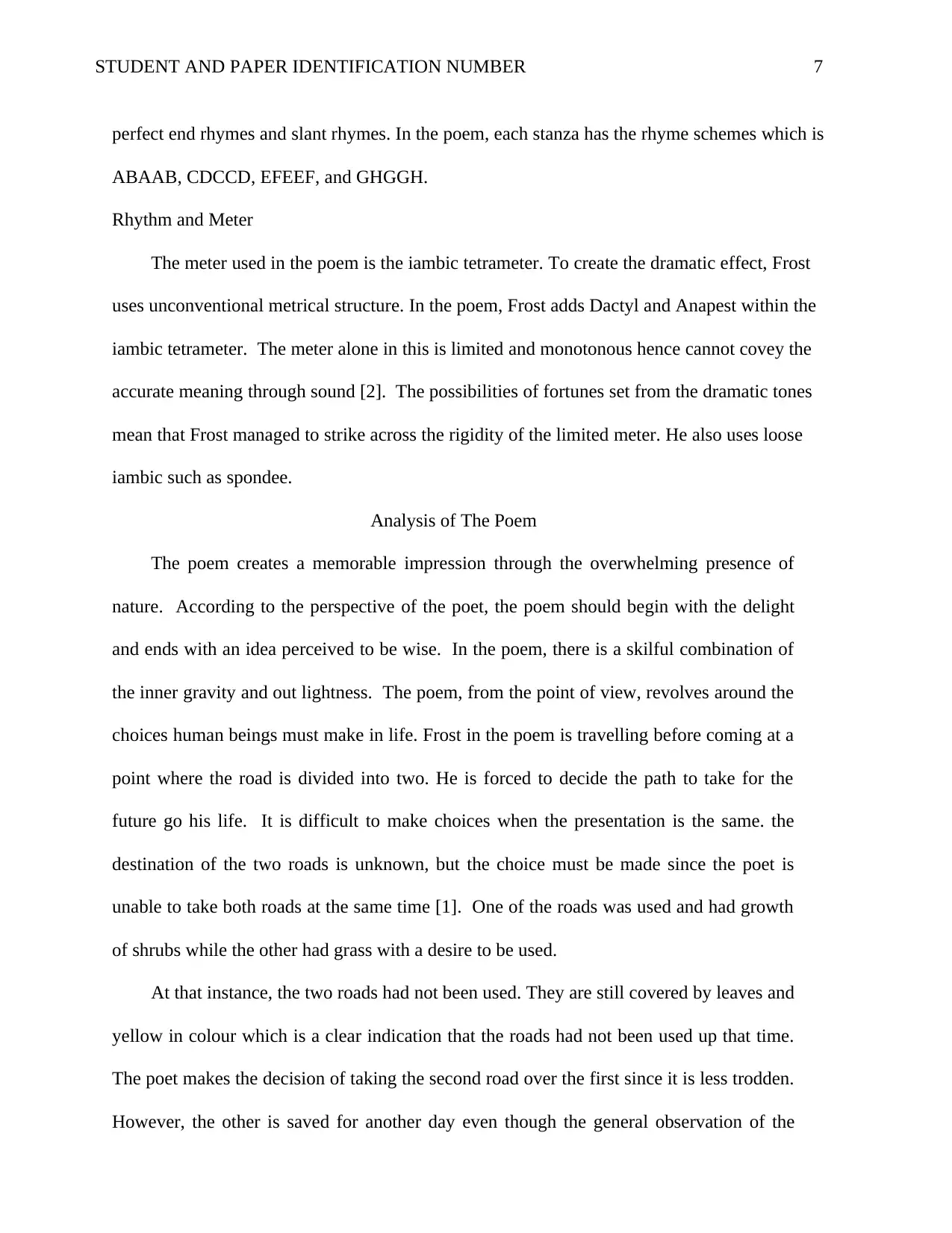
STUDENT AND PAPER IDENTIFICATION NUMBER 7
perfect end rhymes and slant rhymes. In the poem, each stanza has the rhyme schemes which is
ABAAB, CDCCD, EFEEF, and GHGGH.
Rhythm and Meter
The meter used in the poem is the iambic tetrameter. To create the dramatic effect, Frost
uses unconventional metrical structure. In the poem, Frost adds Dactyl and Anapest within the
iambic tetrameter. The meter alone in this is limited and monotonous hence cannot covey the
accurate meaning through sound [2]. The possibilities of fortunes set from the dramatic tones
mean that Frost managed to strike across the rigidity of the limited meter. He also uses loose
iambic such as spondee.
Analysis of The Poem
The poem creates a memorable impression through the overwhelming presence of
nature. According to the perspective of the poet, the poem should begin with the delight
and ends with an idea perceived to be wise. In the poem, there is a skilful combination of
the inner gravity and out lightness. The poem, from the point of view, revolves around the
choices human beings must make in life. Frost in the poem is travelling before coming at a
point where the road is divided into two. He is forced to decide the path to take for the
future go his life. It is difficult to make choices when the presentation is the same. the
destination of the two roads is unknown, but the choice must be made since the poet is
unable to take both roads at the same time [1]. One of the roads was used and had growth
of shrubs while the other had grass with a desire to be used.
At that instance, the two roads had not been used. They are still covered by leaves and
yellow in colour which is a clear indication that the roads had not been used up that time.
The poet makes the decision of taking the second road over the first since it is less trodden.
However, the other is saved for another day even though the general observation of the
perfect end rhymes and slant rhymes. In the poem, each stanza has the rhyme schemes which is
ABAAB, CDCCD, EFEEF, and GHGGH.
Rhythm and Meter
The meter used in the poem is the iambic tetrameter. To create the dramatic effect, Frost
uses unconventional metrical structure. In the poem, Frost adds Dactyl and Anapest within the
iambic tetrameter. The meter alone in this is limited and monotonous hence cannot covey the
accurate meaning through sound [2]. The possibilities of fortunes set from the dramatic tones
mean that Frost managed to strike across the rigidity of the limited meter. He also uses loose
iambic such as spondee.
Analysis of The Poem
The poem creates a memorable impression through the overwhelming presence of
nature. According to the perspective of the poet, the poem should begin with the delight
and ends with an idea perceived to be wise. In the poem, there is a skilful combination of
the inner gravity and out lightness. The poem, from the point of view, revolves around the
choices human beings must make in life. Frost in the poem is travelling before coming at a
point where the road is divided into two. He is forced to decide the path to take for the
future go his life. It is difficult to make choices when the presentation is the same. the
destination of the two roads is unknown, but the choice must be made since the poet is
unable to take both roads at the same time [1]. One of the roads was used and had growth
of shrubs while the other had grass with a desire to be used.
At that instance, the two roads had not been used. They are still covered by leaves and
yellow in colour which is a clear indication that the roads had not been used up that time.
The poet makes the decision of taking the second road over the first since it is less trodden.
However, the other is saved for another day even though the general observation of the
Paraphrase This Document
Need a fresh take? Get an instant paraphrase of this document with our AI Paraphraser
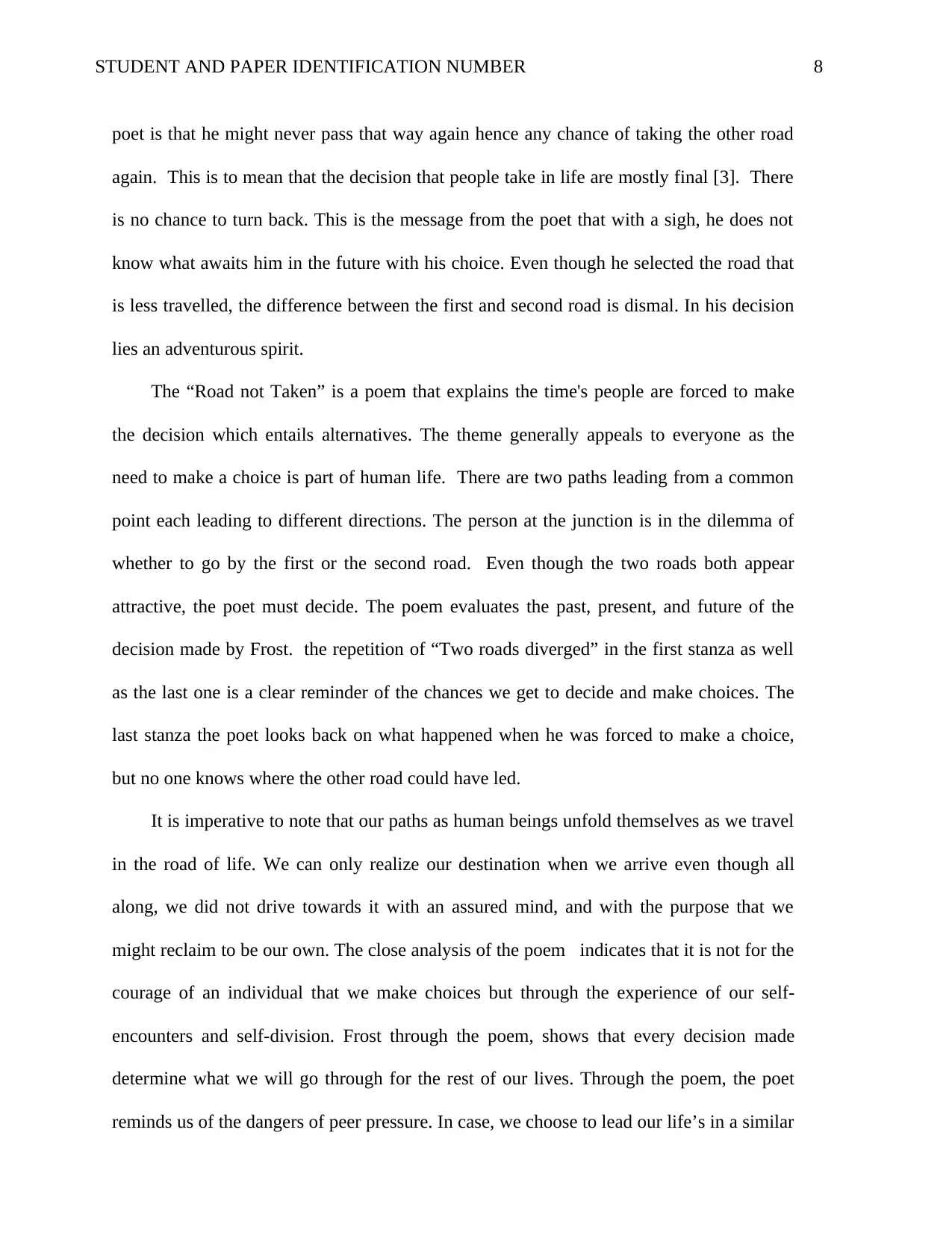
STUDENT AND PAPER IDENTIFICATION NUMBER 8
poet is that he might never pass that way again hence any chance of taking the other road
again. This is to mean that the decision that people take in life are mostly final [3]. There
is no chance to turn back. This is the message from the poet that with a sigh, he does not
know what awaits him in the future with his choice. Even though he selected the road that
is less travelled, the difference between the first and second road is dismal. In his decision
lies an adventurous spirit.
The “Road not Taken” is a poem that explains the time's people are forced to make
the decision which entails alternatives. The theme generally appeals to everyone as the
need to make a choice is part of human life. There are two paths leading from a common
point each leading to different directions. The person at the junction is in the dilemma of
whether to go by the first or the second road. Even though the two roads both appear
attractive, the poet must decide. The poem evaluates the past, present, and future of the
decision made by Frost. the repetition of “Two roads diverged” in the first stanza as well
as the last one is a clear reminder of the chances we get to decide and make choices. The
last stanza the poet looks back on what happened when he was forced to make a choice,
but no one knows where the other road could have led.
It is imperative to note that our paths as human beings unfold themselves as we travel
in the road of life. We can only realize our destination when we arrive even though all
along, we did not drive towards it with an assured mind, and with the purpose that we
might reclaim to be our own. The close analysis of the poem indicates that it is not for the
courage of an individual that we make choices but through the experience of our self-
encounters and self-division. Frost through the poem, shows that every decision made
determine what we will go through for the rest of our lives. Through the poem, the poet
reminds us of the dangers of peer pressure. In case, we choose to lead our life’s in a similar
poet is that he might never pass that way again hence any chance of taking the other road
again. This is to mean that the decision that people take in life are mostly final [3]. There
is no chance to turn back. This is the message from the poet that with a sigh, he does not
know what awaits him in the future with his choice. Even though he selected the road that
is less travelled, the difference between the first and second road is dismal. In his decision
lies an adventurous spirit.
The “Road not Taken” is a poem that explains the time's people are forced to make
the decision which entails alternatives. The theme generally appeals to everyone as the
need to make a choice is part of human life. There are two paths leading from a common
point each leading to different directions. The person at the junction is in the dilemma of
whether to go by the first or the second road. Even though the two roads both appear
attractive, the poet must decide. The poem evaluates the past, present, and future of the
decision made by Frost. the repetition of “Two roads diverged” in the first stanza as well
as the last one is a clear reminder of the chances we get to decide and make choices. The
last stanza the poet looks back on what happened when he was forced to make a choice,
but no one knows where the other road could have led.
It is imperative to note that our paths as human beings unfold themselves as we travel
in the road of life. We can only realize our destination when we arrive even though all
along, we did not drive towards it with an assured mind, and with the purpose that we
might reclaim to be our own. The close analysis of the poem indicates that it is not for the
courage of an individual that we make choices but through the experience of our self-
encounters and self-division. Frost through the poem, shows that every decision made
determine what we will go through for the rest of our lives. Through the poem, the poet
reminds us of the dangers of peer pressure. In case, we choose to lead our life’s in a similar
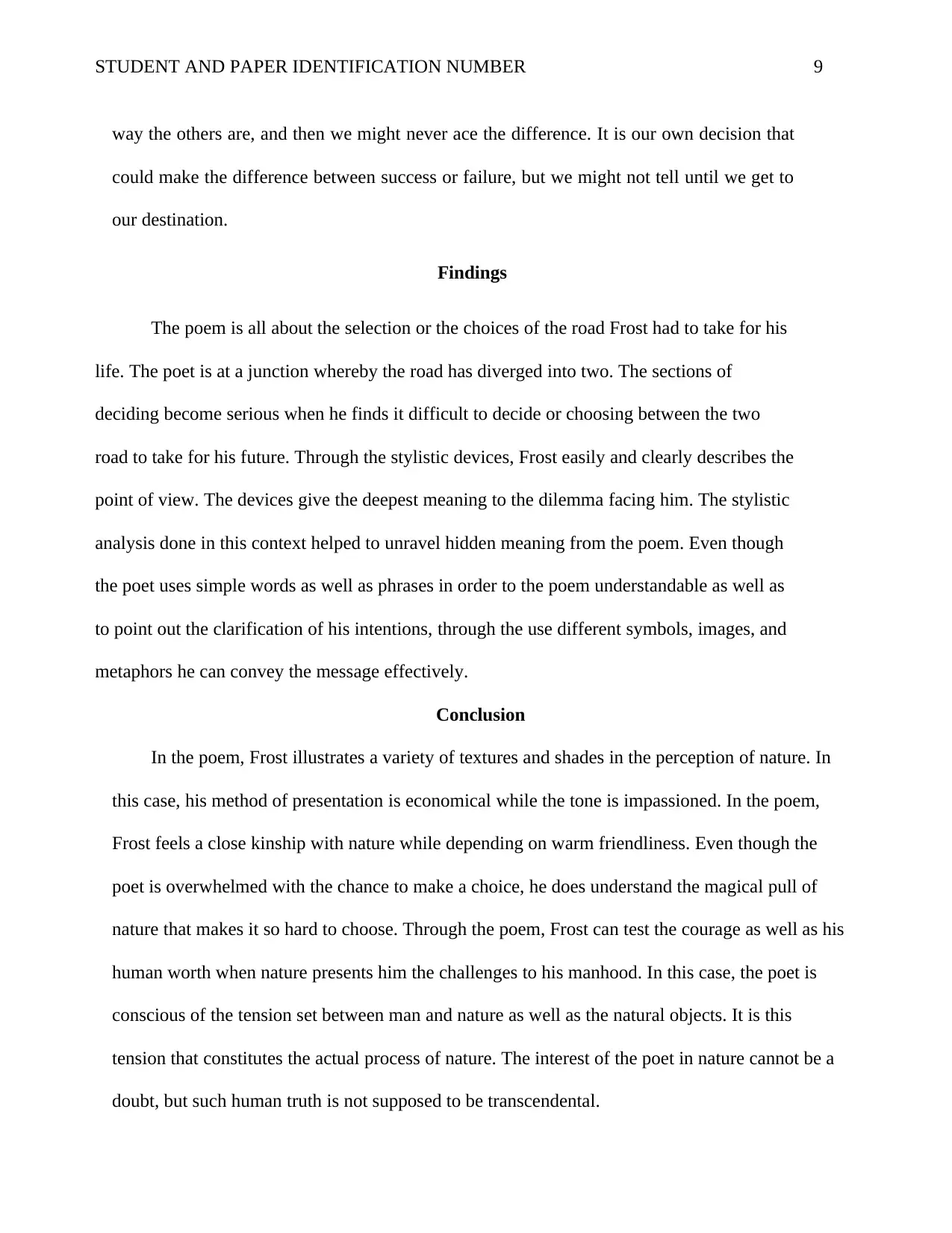
STUDENT AND PAPER IDENTIFICATION NUMBER 9
way the others are, and then we might never ace the difference. It is our own decision that
could make the difference between success or failure, but we might not tell until we get to
our destination.
Findings
The poem is all about the selection or the choices of the road Frost had to take for his
life. The poet is at a junction whereby the road has diverged into two. The sections of
deciding become serious when he finds it difficult to decide or choosing between the two
road to take for his future. Through the stylistic devices, Frost easily and clearly describes the
point of view. The devices give the deepest meaning to the dilemma facing him. The stylistic
analysis done in this context helped to unravel hidden meaning from the poem. Even though
the poet uses simple words as well as phrases in order to the poem understandable as well as
to point out the clarification of his intentions, through the use different symbols, images, and
metaphors he can convey the message effectively.
Conclusion
In the poem, Frost illustrates a variety of textures and shades in the perception of nature. In
this case, his method of presentation is economical while the tone is impassioned. In the poem,
Frost feels a close kinship with nature while depending on warm friendliness. Even though the
poet is overwhelmed with the chance to make a choice, he does understand the magical pull of
nature that makes it so hard to choose. Through the poem, Frost can test the courage as well as his
human worth when nature presents him the challenges to his manhood. In this case, the poet is
conscious of the tension set between man and nature as well as the natural objects. It is this
tension that constitutes the actual process of nature. The interest of the poet in nature cannot be a
doubt, but such human truth is not supposed to be transcendental.
way the others are, and then we might never ace the difference. It is our own decision that
could make the difference between success or failure, but we might not tell until we get to
our destination.
Findings
The poem is all about the selection or the choices of the road Frost had to take for his
life. The poet is at a junction whereby the road has diverged into two. The sections of
deciding become serious when he finds it difficult to decide or choosing between the two
road to take for his future. Through the stylistic devices, Frost easily and clearly describes the
point of view. The devices give the deepest meaning to the dilemma facing him. The stylistic
analysis done in this context helped to unravel hidden meaning from the poem. Even though
the poet uses simple words as well as phrases in order to the poem understandable as well as
to point out the clarification of his intentions, through the use different symbols, images, and
metaphors he can convey the message effectively.
Conclusion
In the poem, Frost illustrates a variety of textures and shades in the perception of nature. In
this case, his method of presentation is economical while the tone is impassioned. In the poem,
Frost feels a close kinship with nature while depending on warm friendliness. Even though the
poet is overwhelmed with the chance to make a choice, he does understand the magical pull of
nature that makes it so hard to choose. Through the poem, Frost can test the courage as well as his
human worth when nature presents him the challenges to his manhood. In this case, the poet is
conscious of the tension set between man and nature as well as the natural objects. It is this
tension that constitutes the actual process of nature. The interest of the poet in nature cannot be a
doubt, but such human truth is not supposed to be transcendental.
⊘ This is a preview!⊘
Do you want full access?
Subscribe today to unlock all pages.

Trusted by 1+ million students worldwide
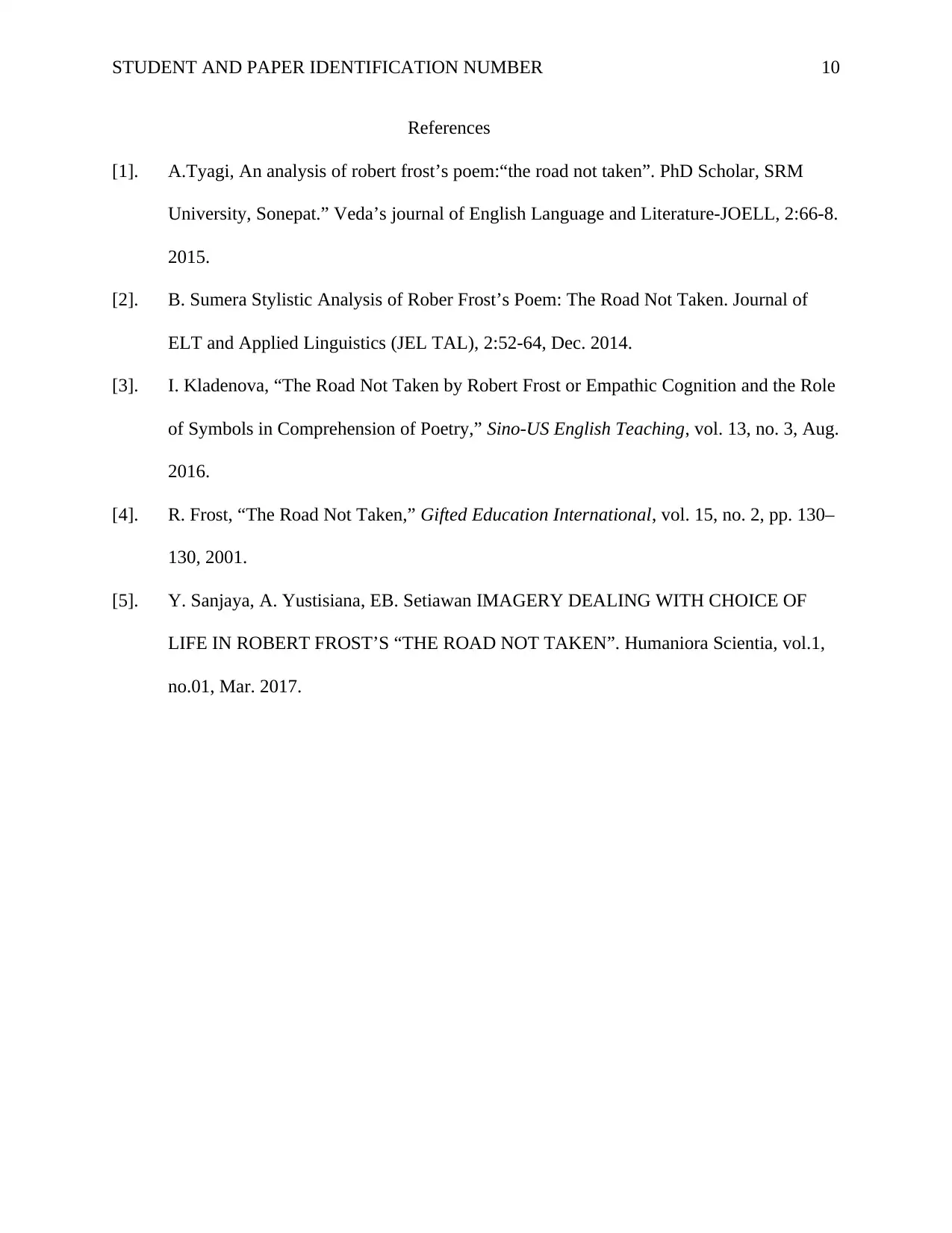
STUDENT AND PAPER IDENTIFICATION NUMBER 10
References
[1]. A.Tyagi, An analysis of robert frost’s poem:“the road not taken”. PhD Scholar, SRM
University, Sonepat.” Veda’s journal of English Language and Literature-JOELL, 2:66-8.
2015.
[2]. B. Sumera Stylistic Analysis of Rober Frost’s Poem: The Road Not Taken. Journal of
ELT and Applied Linguistics (JEL TAL), 2:52-64, Dec. 2014.
[3]. I. Kladenova, “The Road Not Taken by Robert Frost or Empathic Cognition and the Role
of Symbols in Comprehension of Poetry,” Sino-US English Teaching, vol. 13, no. 3, Aug.
2016.
[4]. R. Frost, “The Road Not Taken,” Gifted Education International, vol. 15, no. 2, pp. 130–
130, 2001.
[5]. Y. Sanjaya, A. Yustisiana, EB. Setiawan IMAGERY DEALING WITH CHOICE OF
LIFE IN ROBERT FROST’S “THE ROAD NOT TAKEN”. Humaniora Scientia, vol.1,
no.01, Mar. 2017.
References
[1]. A.Tyagi, An analysis of robert frost’s poem:“the road not taken”. PhD Scholar, SRM
University, Sonepat.” Veda’s journal of English Language and Literature-JOELL, 2:66-8.
2015.
[2]. B. Sumera Stylistic Analysis of Rober Frost’s Poem: The Road Not Taken. Journal of
ELT and Applied Linguistics (JEL TAL), 2:52-64, Dec. 2014.
[3]. I. Kladenova, “The Road Not Taken by Robert Frost or Empathic Cognition and the Role
of Symbols in Comprehension of Poetry,” Sino-US English Teaching, vol. 13, no. 3, Aug.
2016.
[4]. R. Frost, “The Road Not Taken,” Gifted Education International, vol. 15, no. 2, pp. 130–
130, 2001.
[5]. Y. Sanjaya, A. Yustisiana, EB. Setiawan IMAGERY DEALING WITH CHOICE OF
LIFE IN ROBERT FROST’S “THE ROAD NOT TAKEN”. Humaniora Scientia, vol.1,
no.01, Mar. 2017.
1 out of 10
Your All-in-One AI-Powered Toolkit for Academic Success.
+13062052269
info@desklib.com
Available 24*7 on WhatsApp / Email
![[object Object]](/_next/static/media/star-bottom.7253800d.svg)
Unlock your academic potential
Copyright © 2020–2025 A2Z Services. All Rights Reserved. Developed and managed by ZUCOL.

